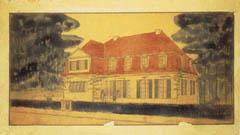Mies van der Rohe
dal 9/12/2002 al 2/3/2003
Segnalato da
9/12/2002
Mies van der Rohe
Whitechapel, London
1905 - 1938. Ludwig Mies van der Rohe (1886 - 1969) is one of the masters of 20th Century architecture. Famed for his ethos of 'less is more', his designs have reshaped skylines and revolutionised interior, urban and suburban space. This definitive retrospective of his career in Europe - the first in the UK - brings together 38 pivotal projects dating from Mies' arrival in Berlin in 1905 to his departure for the US in 1938.

1905 - 1938
Ludwig Mies van der Rohe (1886 - 1969) is one of the masters of 20th Century architecture. Famed for his ethos of 'less is more', his designs have reshaped skylines and revolutionised interior, urban and suburban space. This definitive retrospective of his career in Europe - the first in the UK - brings together 38 pivotal projects dating from Mies' arrival in Berlin in 1905 to his departure for the US in 1938. Featuring elegant villas, prototype skyscrapers and his remarkable German Pavilion for the Barcelona International Exposition, the exhibition also includes the work of modern masters and contemporary artists inspired by the architecture of Mies.
Born Ludwig Mies in Aachen, Germany, he began his career in his family's stone-carving business, moving to Berlin in 1905 to work for architect and furniture designer Bruno Paul. Only 20 years old, he designed and built the first of many domestic projects which characterised his German career. His work caught the attention of Peter Behrens, the most progressive architect of the times, for whom Mies was to work from 1908 to 1912. During this first decade of his career, Mies developed complete domestic environments for the lake and woodland suburbs near Potsdam - reflecting the contemporary reassessment of the role of the architect to include interior and garden design.
In the 10 years after World War I, Mies' attention increasingly turned to the city of Berlin and its emerging culture of radical art and architecture. His ideas about housing, commercial buildings and monuments were as simple as they were ambitious - to create a universal vocabulary for architecture that emphasised its fundamental elements and principles, gradually paring down decorative elements to create a minimal style. He embraced the use of new technology, using materials such as glass, concrete and steel which he saw as a 'means towards a spiritual purpose'. His proposal for a skyscraper in Berlin's Friedrichstrasse in 1921 was the first for a high-rise building entirely clad in glass. Such innovative designs were often created for exhibitions or magazines, such as the famous G magazine - which brought together works and writings by artists such as Hans Arp, Theo van Doesburg, George Grosz and Man Ray, also included in the exhibition. In 1927 he organised the Werkbund Exposition in Stuttgart, which featured other leading architects such as Le Corbusier and Walter Gropius. Alongside ambitious designs for the modern metropolis Mies continued to explore the relationship between the individual and nature in his domestic projects throughout the 1920s.
The thirties brought economic depression coupled with the emergence of the National Socialist regime, both of which gradually restricted Mies' practice. He was the last director of the influential Bauhaus School of Art & Design, until its closure by the Nazis in 1933. His work returned to the theme of architecture and landscape in a number of significant projects which were never built. Mies left Germany to start a new career in the US in 1938. Despite being one of Europe's leading architects, he fled Nazi Germany penniless, with little English and on his brother's passport.
Mies van der Rohe 1905 - 1938 re-evaluates the importance of his early to mid career, revealing the architect as a shaper of the bustling metropolis and its emerging suburbs. Projects are explored through drawings, photographs, models and videos and are presented in two chronological paths which juxtapose Mies' suburban projects with those designed for the urban environment. The show also includes works by Peter Behrens, Karl Friedrich Schinkel and Frank Lloyd Wright - architects who deeply influenced Mies' vision. Testifying to his importance for artists today are a group of remarkable photographs by German artist Thomas Ruff, whose images of Mies' buildings provide a contemporary re-interpretation of his enduring legacy.
The exhibition is curated by Terence Riley, Chief Curator, Department of Architecture and Design, The Museum of Modern Art, New York and Barry Bergdoll, Professor of Art History, Columbia University, New York and organised by The Museum of Modern Art, New York. The exhibition was organised at the Whitechapel Art Gallery, London, by Andrea Tarsia, Head of Exhibitions & Projects.
The Whitechapel Art Gallery also gratefully acknowledges the support of the Goethe-Institut Inter Nationes and the Arts Council of England.
Exhibition design by Fern Green.
The exhibition at The Museum of Modern Art was made possible by UBS PaineWebber. Funds for research and planning were provided by the Getty Grant Programme. Generous support was also provided by the Lily Auchincloss Foundation, Inc., Peter Norton, Norton Family Foundation, Tishman Speyer Properties, and Knoll, Inc. Additional funding was provided by Elise Jaffe and Jeffrey Brown, Mrs. Frances Lewis, Sarah Peter, and the Government of The Federal Republic of Germany. This exhibition is travelling under the auspices of the International Council of The Museum of Modern Art, New York.
The presentation of Mies in London was sponsored by the Mies Group: Arup, Davis Langdon & Everest, Linklaters, Skidmore, Owings & Merrill (SOM) and YRM.
£6/4.50 concessions
Free for Whitechapel supporters and free on Tuesdays
Open Tuesday - Sunday 11 - 6pm
Image: Mies van der Rohe, Werner House, perspective view from street. 1912. Pencil and watercolour on tracing paper. 27 x 54.2 cm. Bauhaus Archive, Berlin.
Recorded information 020 7522 7878 Other enquiries 020 7522 7888 Fax 020 7377 1685 Minicom 020 7522 7854
Whitechapel Art Gallery
80-82 Whitechapel High Street
London
E1 7QX



